Feruloyl Esterase (LaFae) from Lactobacillus acidophilus: Structural Insights and Functional Characterization for Application in Ferulic Acid Production
Abstract
1. Introduction
2. Results and Discussion
2.1. Bioinformatic Analysis of LaFae
2.2. Characterizations of LaFae
2.3. Enzymatic Properties of LaFae
2.4. Structural Analysis of LaFae
2.5. Mutational Analyses of LaFae
2.6. Ferulic Acid Production Using LaFae
3. Materials and Methods
3.1. Chemicals and Reagents
3.2. Preparation of Wild-Type and Mutants of LaFae
3.3. Oligomerization of LaFae
3.4. Measurement of Esterase Activity
3.5. Chemical Stability Assay
3.6. Thermal Stability and Circular Dichroism Analysis
3.7. Hydrolytic Activity Assay
3.8. Crystallization and Data Collection
3.9. Structure Determination and Refinement
3.10. Determination of LaFae Feruloyl Esterase Activity
4. Conclusions
Supplementary Materials
Author Contributions
Funding
Informed Consent Statement
Data Availability Statement
Acknowledgments
Conflicts of Interest
References
- Białecka-Florjańczyk, E.; Fabiszewska, A.; Zieniuk, B. Phenolic acids derivatives—Biotechnological methods of synthesis and bioactivity. Curr. Pharm. Biotechnol. 2018, 19, 1098–1113. [Google Scholar] [CrossRef] [PubMed]
- Coman, V.; Vodnar, D.C. Hydroxycinnamic acids and human health: Recent advances. J. Sci. Food Agric. 2020, 100, 483–499. [Google Scholar] [CrossRef] [PubMed]
- Taofiq, O.; González-Paramás, A.M.; Barreiro, M.F.; Ferreira, I.C. Hydroxycinnamic acids and their derivatives: Cosmeceutical significance, challenges and future perspectives, a review. Molecules 2017, 22, 281. [Google Scholar] [CrossRef] [PubMed]
- Tinikul, R.; Chenprakhon, P.; Maenpuen, S.; Chaiyen, P. Biotransformation of plant-derived phenolic acids. Biotechnol. J. 2018, 13, e1700632. [Google Scholar] [CrossRef] [PubMed]
- Koseki, T.; Fushinobu, S.; Ardiansyah; Shirakawa, H.; Komai, M. Occurrence, properties, and applications of feruloyl esterases. Appl. Microbiol. Biotechnol. 2009, 84, 803–810. [Google Scholar] [CrossRef]
- Oliveira, D.M.; Mota, T.R.; Oliva, B.; Segato, F.; Marchiosi, R.; Ferrarese-Filho, O.; Faulds, C.B.; Dos Santos, W.D. Feruloyl esterases: Biocatalysts to overcome biomass recalcitrance and for the production of bioactive compounds. Bioresour. Technol. 2019, 278, 408–423. [Google Scholar] [CrossRef] [PubMed]
- Wong, D.W. Feruloyl esterase: A key enzyme in biomass degradation. Appl. Biochem. Biotechnol. 2006, 133, 87–112. [Google Scholar] [CrossRef] [PubMed]
- Gopalan, N.; Rodríguez-Duran, L.V.; Saucedo-Castaneda, G.; Nampoothiri, K.M. Review on technological and scientific aspects of feruloyl esterases: A versatile enzyme for biorefining of biomass. Bioresour. Technol. 2015, 193, 534–544. [Google Scholar] [CrossRef] [PubMed]
- Cheng, F.; Sheng, J.; Dong, R.; Men, Y.; Gan, L.; Shen, L. Novel xylanase from a holstein cattle rumen metagenomic library and its application in xylooligosaccharide and ferulic acid production from wheat straw. J. Agric. Food Chem. 2012, 60, 12516–12524. [Google Scholar] [CrossRef] [PubMed]
- Wefers, D.; Cavalcante, J.J.V.; Schendel, R.R.; Deveryshetty, J.; Wang, K.; Wawrzak, Z.; Mackie, R.I.; Koropatkin, N.M.; Cann, I. Biochemical and structural analyses of two cryptic esterases in Bacteroides intestinalis and their synergistic activities with cognate xylanases. J. Mol. Biol. 2017, 429, 2509–2527. [Google Scholar] [CrossRef] [PubMed]
- Liu, S.; Soomro, L.; Wei, X.; Yuan, X.; Gu, T.; Li, Z.; Wang, Y.; Bao, Y.; Wang, F.; Wen, B.; et al. Directed evolution of feruloyl esterase from Lactobacillus acidophilus and its application for ferulic acid production. Bioresour. Technol. 2021, 332, 124967. [Google Scholar] [CrossRef] [PubMed]
- Fritsch, C.; Jänsch, A.; Ehrmann, M.A.; Toelstede, S.; Vogel, R.F. Characterization of cinnamoyl esterases from different lactobacilli and bifidobacteria. Curr. Microbiol. 2017, 74, 247–256. [Google Scholar] [CrossRef] [PubMed]
- Song, Y.R.; Baik, S.H. Molecular cloning, purification, and characterization of a novel thermostable cinnamoyl esterase from Lactobacillus helveticus KCCM 11223. Prep. Biochem. Biotechnol. 2017, 47, 496–504. [Google Scholar] [CrossRef] [PubMed]
- Esteban-Torres, M.; Reverón, I.; Mancheño, J.M.; de Las Rivas, B.; Muñoz, R. Characterization of a feruloyl esterase from Lactobacillus plantarum. Appl. Environ. Microbiol. 2013, 79, 5130–5136. [Google Scholar] [CrossRef] [PubMed]
- Selle, K.; Klaenhammer, T.R. Genomic and phenotypic evidence for probiotic influences of Lactobacillus gasseri on human health. FEMS Microbiol. Rev. 2013, 37, 915–935. [Google Scholar] [CrossRef] [PubMed]
- Anjum, N.; Maqsood, S.; Masud, T.; Ahmad, A.; Sohail, A.; Momin, A. Lactobacillus acidophilus: Characterization of the species and application in food production. Crit. Rev. Food Sci. Nutr. 2014, 54, 1241–1251. [Google Scholar] [CrossRef] [PubMed]
- Goh, Y.J.; Klaenhammer, T.R. Insights into glycogen metabolism in Lactobacillus acidophilus: Impact on carbohydrate metabolism, stress tolerance and gut retention. Microb. Cell Fact. 2014, 13, 94. [Google Scholar] [CrossRef] [PubMed]
- Cho, S.W.; Yim, J.; Seo, S.W. Engineering tools for the development of recombinant lactic acid bacteria. Biotechnol. J. 2020, 15, e1900344. [Google Scholar] [CrossRef] [PubMed]
- Wang, X.; Geng, X.; Egashira, Y.; Sanada, H. Purification and characterization of a feruloyl esterase from the intestinal bacterium Lactobacillus acidophilus. Appl. Environ. Microbiol. 2004, 70, 2367–2372. [Google Scholar] [CrossRef] [PubMed]
- Xu, Z.; He, H.; Zhang, S.; Guo, T.; Kong, J. Characterization of feruloyl esterases Produced by the Four Lactobacillus Species: L. amylovorus, L. acidophilus, L. farciminis and, L. fermentum, Isolated from Ensiled Corn Stover. Front. Microbiol. 2017, 8, 941. [Google Scholar] [CrossRef] [PubMed]
- Li, J.; Cai, S.; Luo, Y.; Dong, X. Three feruloyl esterases in Cellulosilyticum ruminicola H1 act synergistically to hydrolyze esterified polysaccharides. Appl. Environ. Microbiol. 2011, 77, 6141–6147. [Google Scholar] [CrossRef] [PubMed]
- Wang, Y.; Ryu, B.H.; Yoo, W.; Lee, C.W.; Kim, K.K.; Lee, J.H.; Kim, T.D. Identification, characterization, immobilization, and mutational analysis of a novel acetylesterase with industrial potential (LaAcE) from Lactobacillus acidophilus. Biochim. Biophys. Acta Gen. Subj. 2018, 1862, 197–210. [Google Scholar] [CrossRef] [PubMed]
- Bonzom, C.; Schild, L.; Gustafsson, H.; Olsson, L. Feruloyl esterase immobilization in mesoporous silica particles and characterization in hydrolysis and transesterification. BMC Biochem. 2018, 19, 1. [Google Scholar] [CrossRef] [PubMed]
- Remonatto, D.; de Oliveira, J.V.; Manuel Guisan, J.; de Oliveira, D.; Ninow, J.; Fernandez-Lorente, G. Production of FAME and FAEE via alcoholysis of sunflower oil by eversa lipases immobilized on hydrophobic supports. Appl. Biochem. Biotechnol. 2018, 185, 705–716. [Google Scholar] [CrossRef] [PubMed]
- Yoo, W.; Le, L.T.H.L.; Lee, J.H.; Kim, K.K.; Kim, T.D. A novel enantioselective SGNH family esterase (NmSGNH1) from Neisseria meningitides: Characterization, mutational analysis, and ester synthesis. Biochim. Biophys. Acta Mol. Cell Biol. Lipids 2019, 1864, 1438–1448. [Google Scholar] [CrossRef] [PubMed]
- Park, S.H.; Yoo, W.; Lee, C.W.; Jeong, C.S.; Shin, S.C.; Kim, H.W.; Park, H.; Kim, K.K.; Kim, T.D.; Lee, J.H. Crystal structure and functional characterization of a cold-active acetyl xylan esterase (PbAcE) from psychrophilic soil microbe Paenibacillus sp. PLoS ONE 2018, 13, e0206260. [Google Scholar] [CrossRef] [PubMed]
- Le, L.T.H.L.; Yoo, W.; Jeon, S.; Lee, C.; Kim, K.K.; Lee, J.H.; Kim, T.D. Biodiesel and flavor compound production using a novel promiscuous cold-adapted SGNH-type lipase (HaSGNH1) from the psychrophilic bacterium Halocynthiibacter arcticus. Biotechnol. Biofuels 2020, 13, 55. [Google Scholar] [CrossRef] [PubMed]
- Rodrigues, J.; Canet, A.; Rivera, I.; Osório, N.M.; Sandoval, G.; Valero, F.; Ferreira-Dias, S. Biodiesel production from crude Jatropha oil catalyzed by non-commercial immobilized heterologous Rhizopus oryzae and Carica papaya lipases. Bioresour. Technol. 2016, 213, 88–95. [Google Scholar] [CrossRef] [PubMed]
- Lai, K.K.; Lorca, G.L.; Gonzalez, C.F. Biochemical properties of two cinnamoyl esterases purified from a Lactobacillus johnsonii strain isolated from stool samples of diabetes-resistant rats. Appl. Environ. Microbiol. 2009, 75, 5018–5024. [Google Scholar] [CrossRef] [PubMed]
- Holm, L.; Rosenström, P. Dali server: Conservation mapping in 3D. Nucleic Acids Res. 2010, 38, W545–W549. [Google Scholar] [CrossRef] [PubMed]
- Goldstone, D.C.; Villas-Bôas, S.G.; Till, M.; Kelly, W.J.; Attwood, G.T.; Arcus, V.L. Structural and Functional Characterization of a Promiscuous Feruloyl Esterase (Est1E) from the Rumen Bacterium Butyrivibrio proteoclasticus. Proteins Struct. Funct. Bioinform. 2010, 78, 1457–1469. [Google Scholar] [CrossRef] [PubMed]
- Aschauer, P.; Zimmermann, R.; Breinbauer, R.; Pavkov-Keller, T.; Oberer, M. The Crystal Structure of Monoacylglycerol Lipase from M. tuberculosis Reveals the Basis for Specific Inhibition. Sci. Rep. 2018, 8, 8948. [Google Scholar] [CrossRef] [PubMed]
- Braga, C.M.P.; Delabona, P.D.S.; Lima, D.J.D.S.; Paixão, D.A.A.; Pradella, J.G.D.C.; Farinas, C.S. Addition of feruloyl esterase and xylanase produced on-site improves sugarcane bagasse hydrolysis. Bioresour. Technol. 2014, 170, 316–324. [Google Scholar] [CrossRef] [PubMed]
- Lei, Z.; Shao, Y.; Yin, X.; Yin, D.; Guo, Y.; Yuan, J. Combination of xylanase and debranching enzymes specific to wheat arabinoxylan improve the growth performance and gut health of broilers. J. Agric. Food Chem. 2016, 64, 4932–4942. [Google Scholar] [CrossRef] [PubMed]
- Kwon, S.; Yoo, W.; Kim, Y.O.; Kim, K.K.; Kim, T.D. Molecular characterization of a novel family VIII esterase with β-lactamase activity (PsEstA) from Paenibacillus sp. Biomolecules 2019, 9, 786. [Google Scholar] [CrossRef] [PubMed]
- Otwinowski, Z.; Minor, W. Processing of X-ray diffraction data collected in oscillation mode. Methods Enzymol. 1997, 276, 307–326. [Google Scholar] [CrossRef] [PubMed]
- Winn, M.D.; Ballard, C.C.; Cowtan, K.D.; Dodson, E.J.; Emsley, P.; Evans, P.R.; Keegan, R.M.; Krissinel, E.B.; Leslie, A.G.; McCoy, A.; et al. Overview of the CCP4 suite and current developments. Acta Crystallogr. D Biol. Crystallogr. 2011, 67, 235–242. [Google Scholar] [CrossRef] [PubMed]
- Emsley, P.; Cowtan, K. Coot: Model-building tools for molecular graphics. Acta Crystallogr. D Biol. Crystallogr. 2004, 60, 2126–2132. [Google Scholar] [CrossRef] [PubMed]
- Murshudov, G.N.; Skubák, P.; Lebedev, A.A.; Pannu, N.S.; Steiner, R.A.; Nicholls, R.A.; Winn, M.D.; Long, F.; Vagin, A.A. REFMAC5 for the refinement of macromolecular crystal structures. Acta Crystallogr. D Biol. Crystallogr. 2011, 67, 355–367. [Google Scholar] [CrossRef] [PubMed]
- Adams, P.D.; Afonine, P.V.; Bunkóczi, G.; Chen, V.B.; Davis, I.W.; Echols, N.; Headd, J.J.; Hung, L.W.; Kapral, G.J.; Grosse-Kunstleve, R.W.; et al. Phenix: A comprehensive Python-based system for macromolecular structure solution. Acta Crystallogr. D Biol. Crystallogr. 2010, 66, 213–221. [Google Scholar] [CrossRef] [PubMed]
- Chen, V.B.; Arendall, W.B., 3rd; Headd, J.J.; Keedy, D.A.; Immormino, R.M.; Kapral, G.J.; Murray, L.W.; Richardson, J.S.; Richardson, D.C. MolProbity: All-atom structure validation for macromolecular crystallography. Acta Crystallogr. D Biol. Crystallogr. 2010, 66, 12–21. [Google Scholar] [CrossRef] [PubMed]
- Schrödinger, L.; DeLano, W. PyMOL. 2020. Available online: http://www.pymol.org/pymol (accessed on 6 May 2023).
- Xu, Z.; Wang, T.; Zhang, S. Extracellular secretion of feruloyl esterase derived from Lactobacillus cristates in Escherichia coli and its application for ferulic acid production. Bioresour. Technol. 2019, 288, 121526. [Google Scholar] [CrossRef] [PubMed]
- Do, H.; Wang, Y.; Lee, C.W.; Yoo, W.; Jeon, S.; Hwang, J.; Lee, M.J.; Kim, K.K.; Kim, H.; Lee, J.H.; et al. Sequence analysis and preliminary X-ray crystallographic analysis of an acetylesterase (LgEstI) from Lactococcus garvieae. Crystals 2022, 12, 46. [Google Scholar] [CrossRef]
- Chong, S.L.; Cardoso, V.; Brás, J.L.A.; Gomes, M.Z.D.V.; Fontes, C.M.G.A.; Olsson, L. Immobilization of bacterial feruloyl esterase on mesoporous silica particles and enhancement of synthetic activity by hydrophobic-modified surface. Bioresour. Technol. 2019, 293, 122009. [Google Scholar] [CrossRef] [PubMed]
- Johnson, K.G.; Harrison, B.A.; Schneider, H.; Mackenzie, C.R.; Fontana, J.D. Xylan-hydrolysing enzymes from Streptomyces spp. Enzyme Microb. Technol. 1988, 10, 403–409. [Google Scholar] [CrossRef]
- Nieter, A.; Haase-Aschoff, P.; Linke, D.; Nimtz, M.; Berger, R.G. A halotolerant type A feruloyl esterase from Pleurotus eryngii. Fungal Biol. 2014, 118, 348–357. [Google Scholar] [CrossRef] [PubMed]
- Labar, G.; Bauvois, C.; Borel, F.; Ferrer, J.L.; Wouters, J.; Lambert, D.M. Crystal Structure of the Human Monoacylglycerol Lipase, a Key Actor in Endocannabinoid Signaling. ChemBioChem 2010, 11, 218–227. [Google Scholar] [CrossRef] [PubMed]
- Franklin, M.C.; Cheung, J.; Rudolph, M.J.; Burshteyn, F.; Cassidy, M.; Gary, E.; Hillerich, B.; Yao, Z.K.; Carlier, P.R.; Totrov, M.; et al. Structural Genomics for Drug Design against the Pathogen Coxiella burnetii. Proteins Struct. Funct. Bioinform. 2015, 83, 2124–2136. [Google Scholar] [CrossRef] [PubMed]

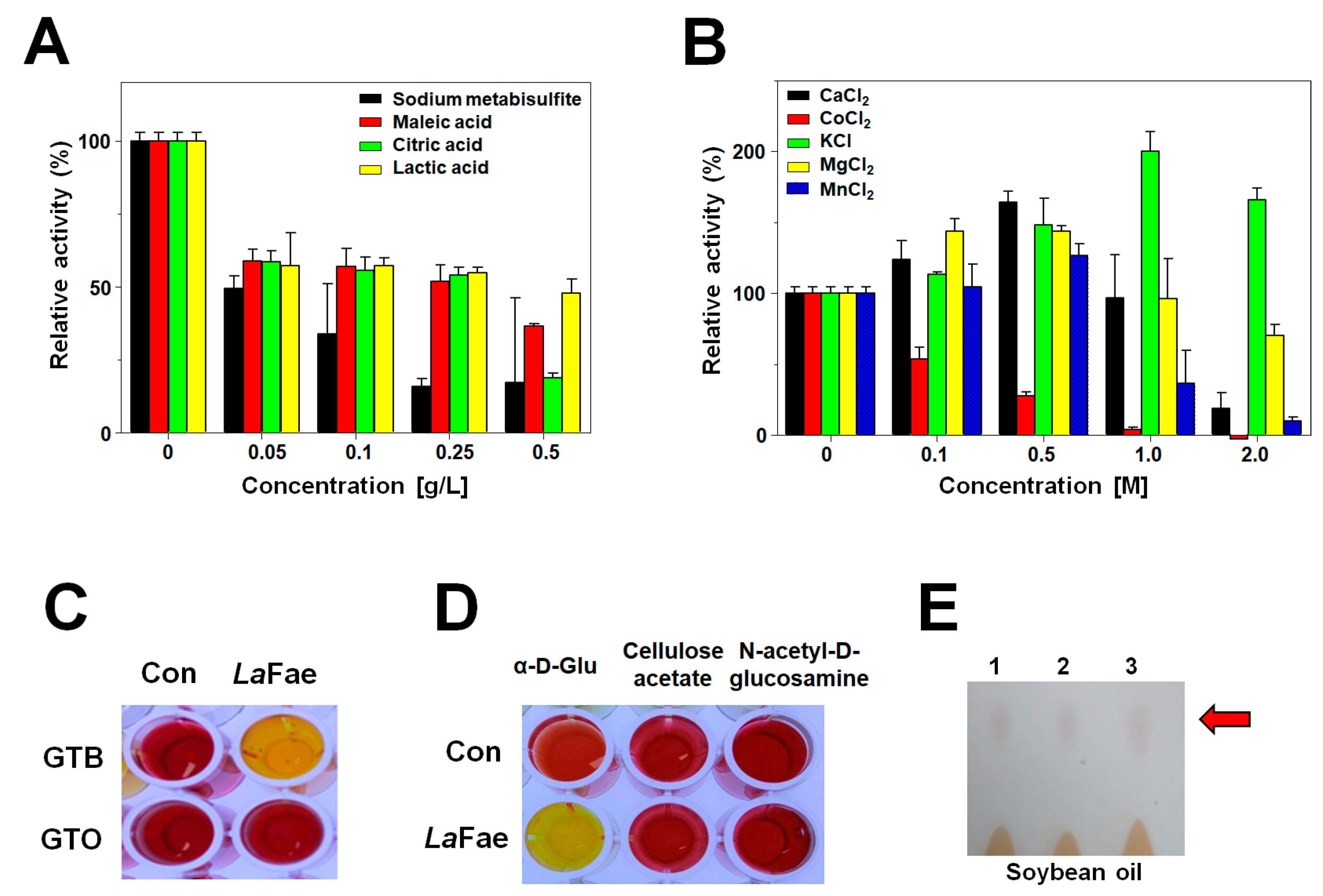
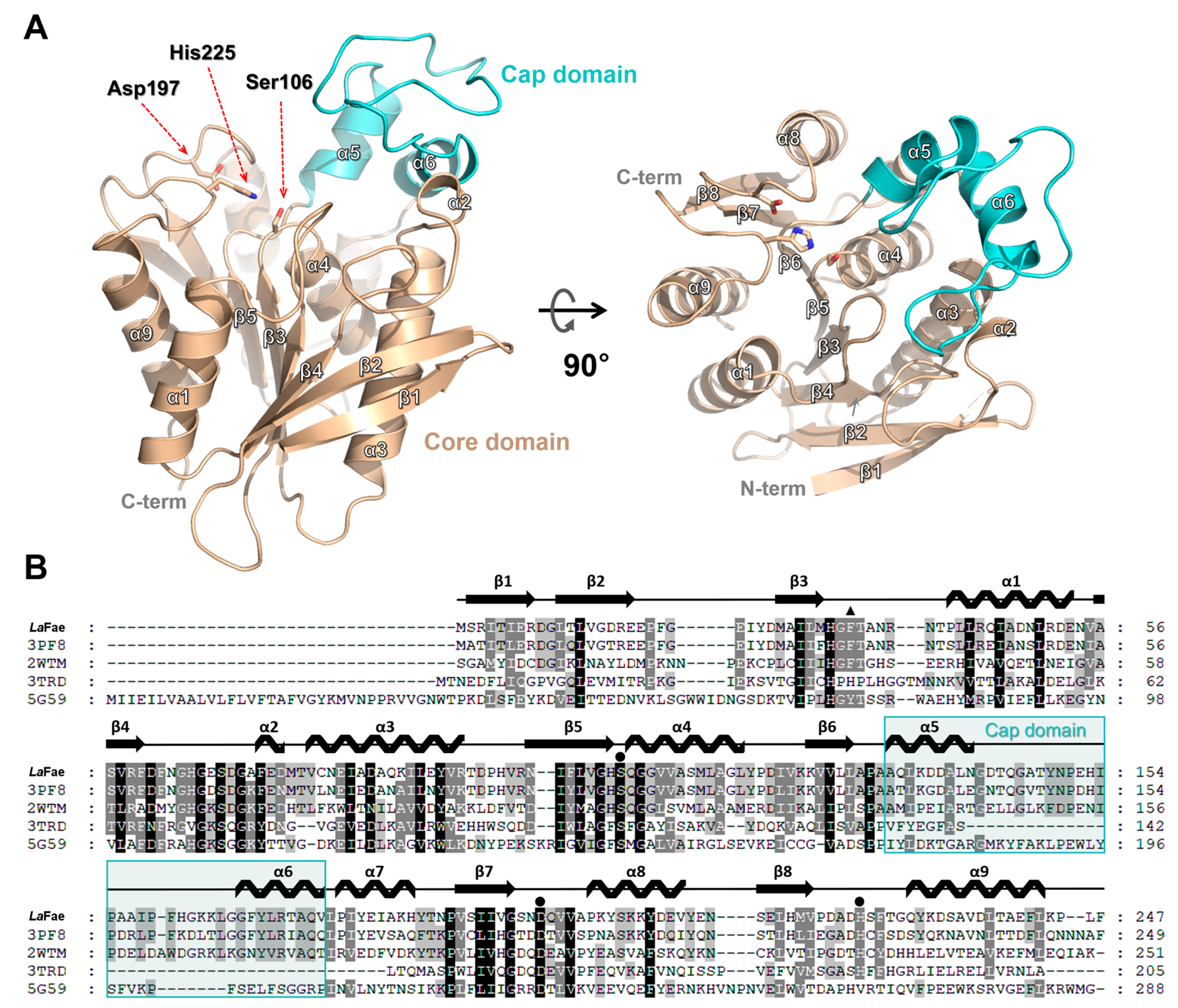
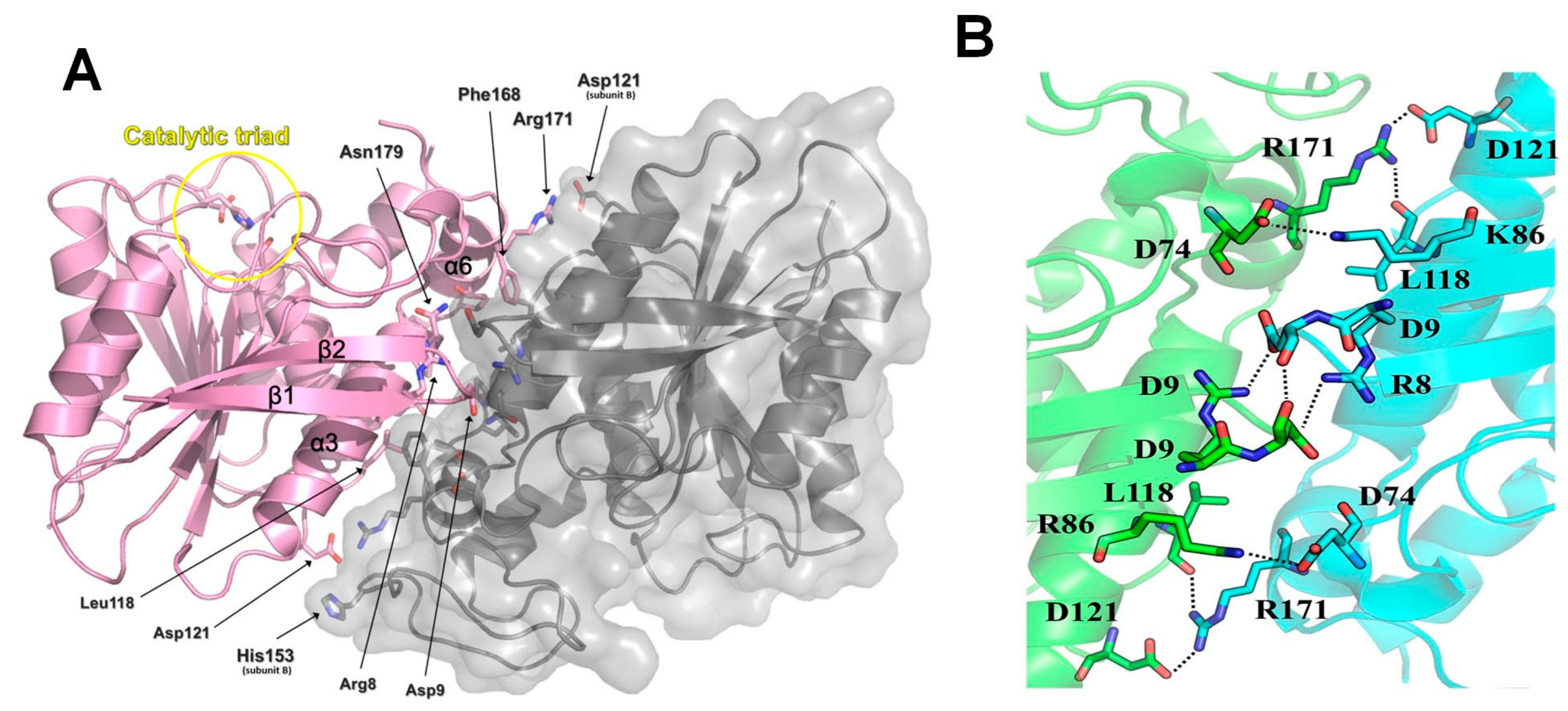
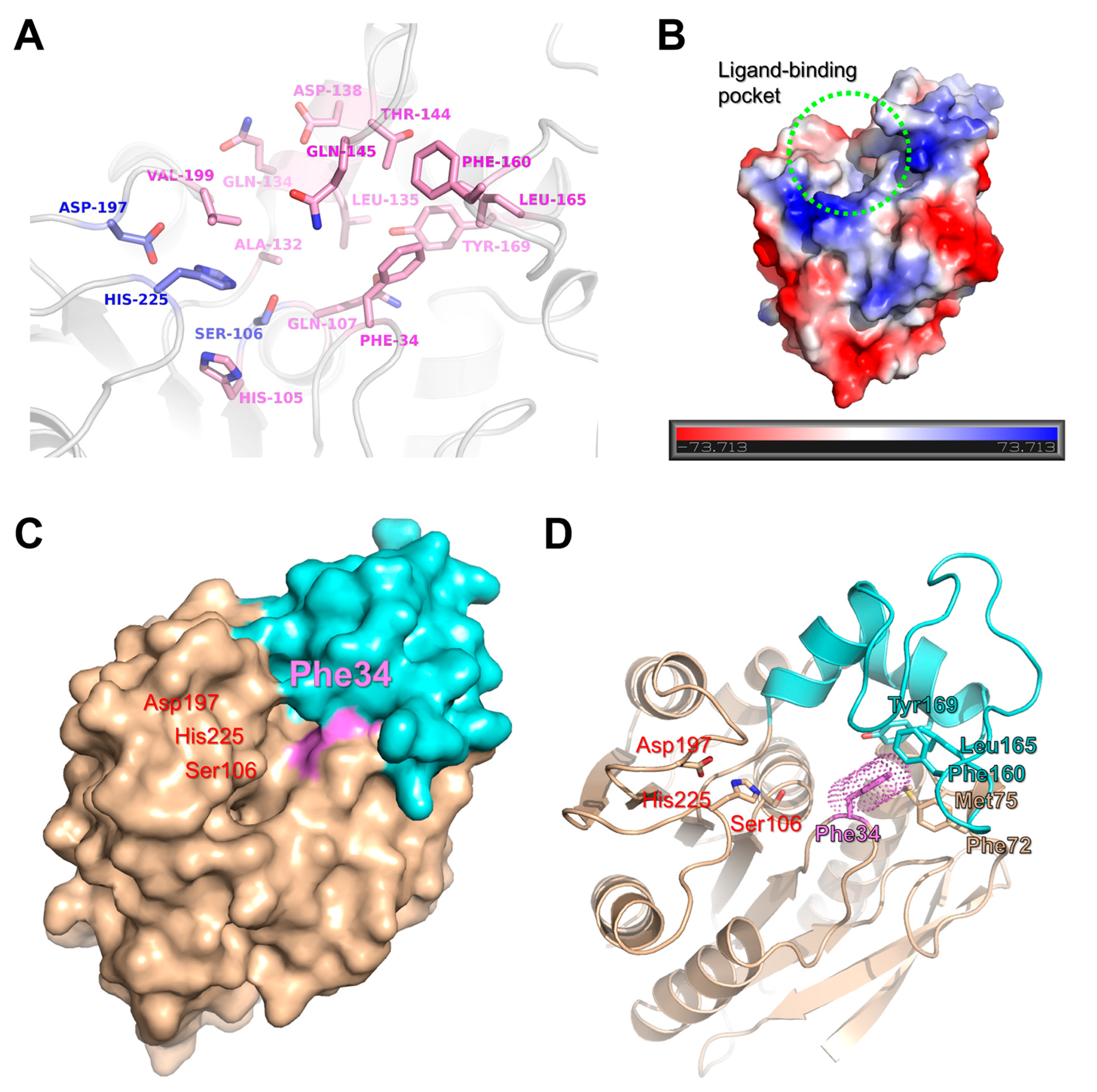
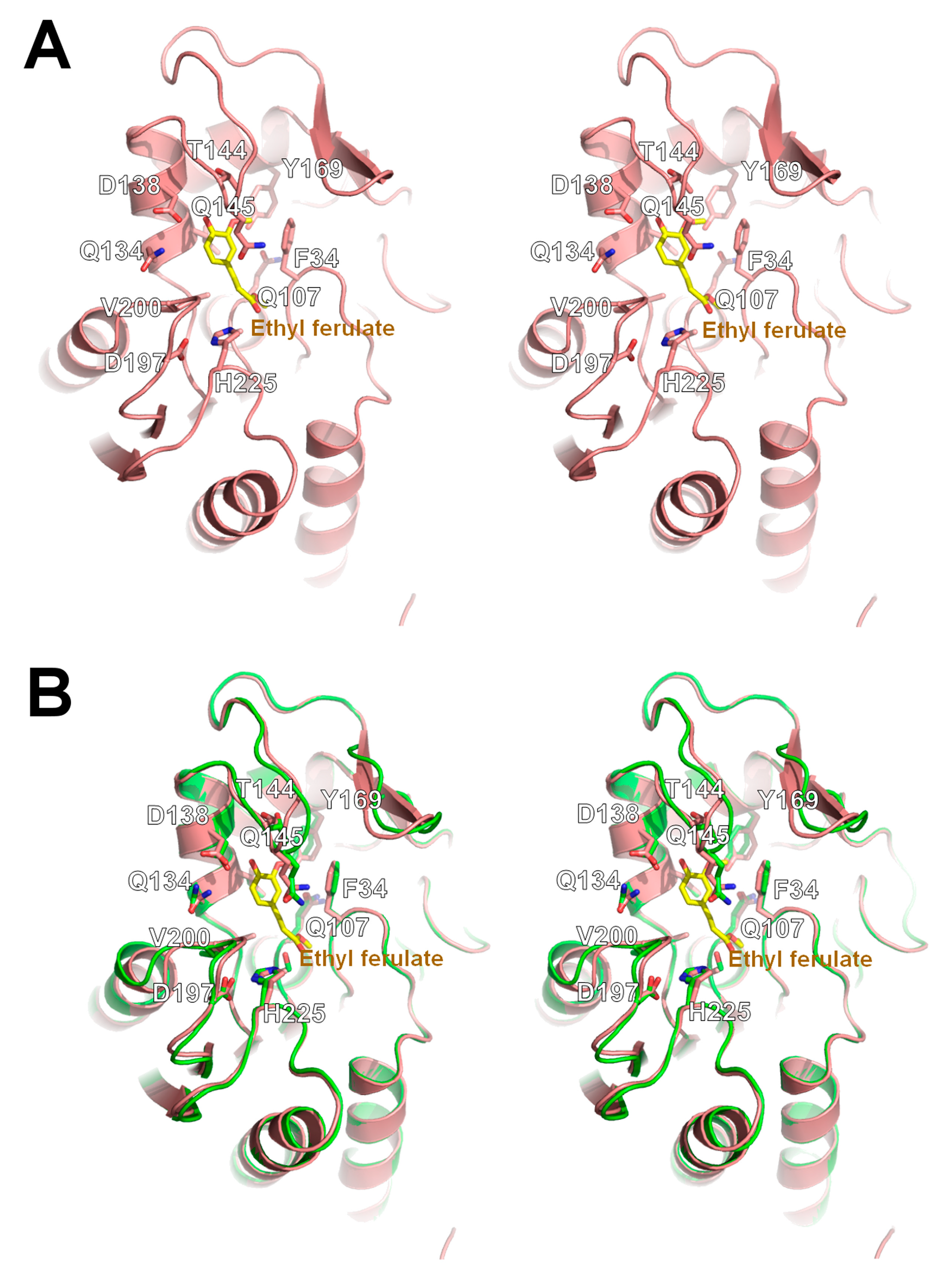
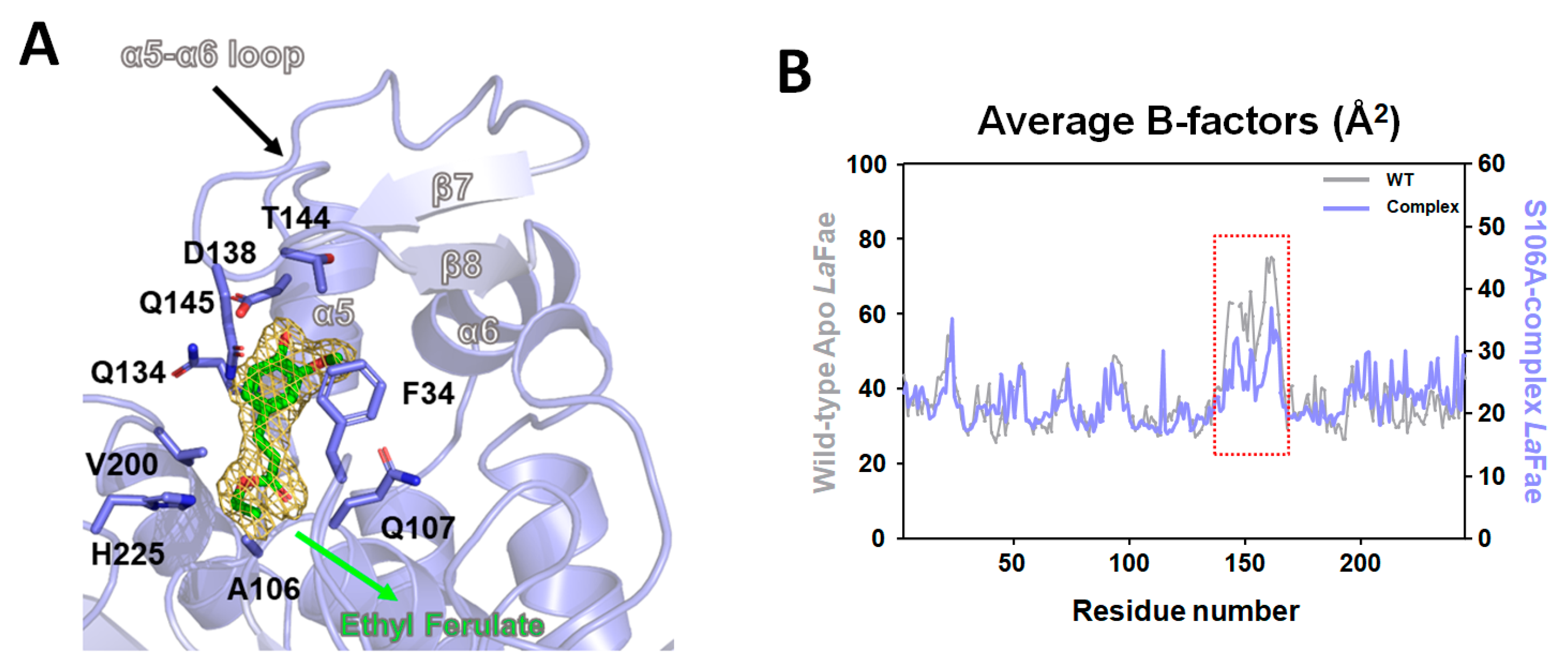
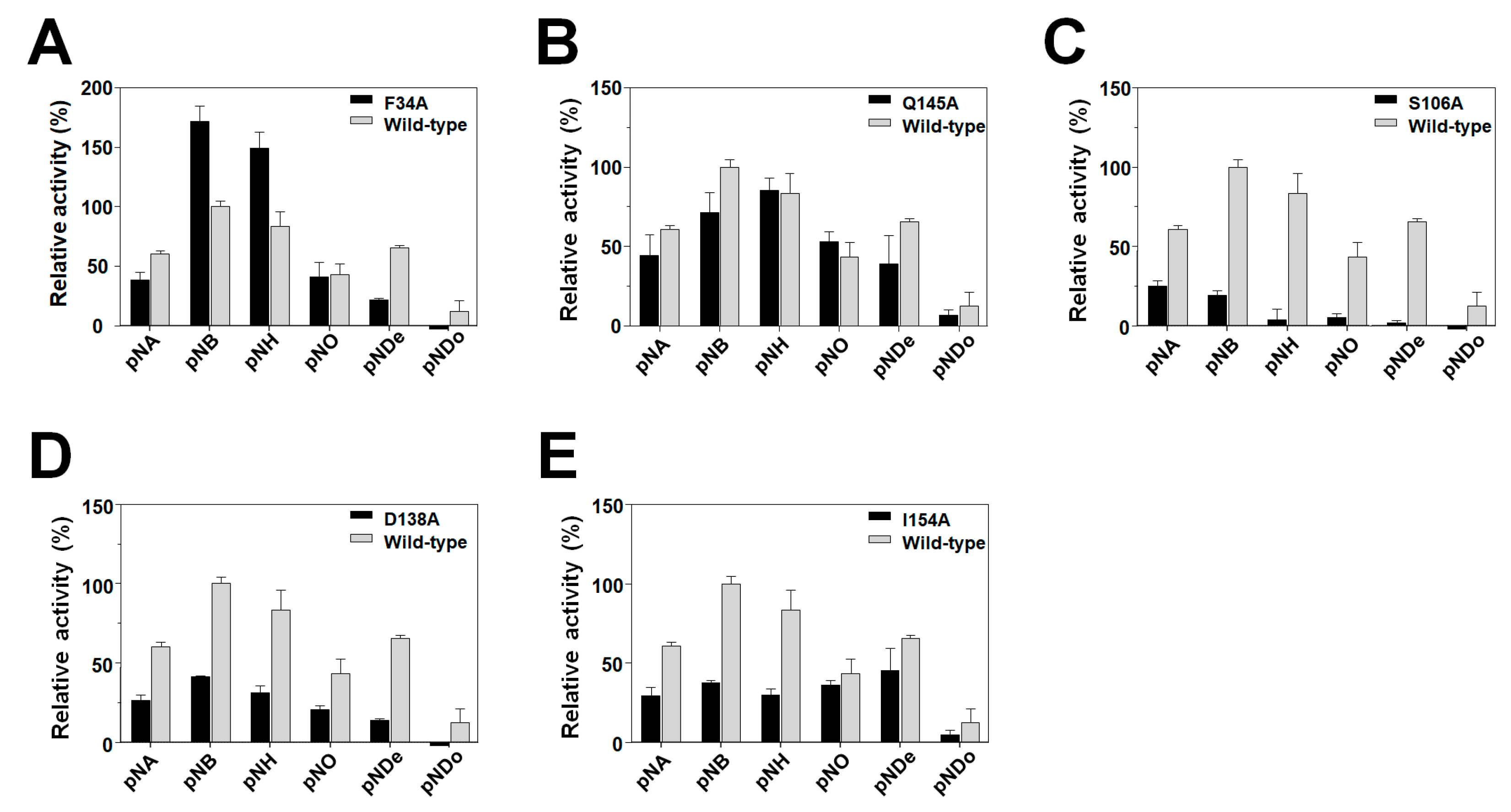

| Data Collection | LaFae | S106A Complex with Ethyl Ferulate |
|---|---|---|
| X-ray source | BL-5C beam line | BL-5C beam line |
| Space group | P212121 | C121 |
| Unit-cell parameters (Å, °) | a = 49.2, b = 74.6, c = 123.4, α = β = γ = 90 | a = 130.4, b = 153.4, c = 91.3, α = 90, β = 127.4, γ = 90 |
| Wavelength (Å) | 0.9794 | 0.9794 |
| Resolution (Å) | 50.00–2.30 (2.34–2.30) | 50.00–2.19 (2.23–2.19) |
| Total reflections | 137,499 | 515,156 |
| Unique reflections | 20,175 (1031) | 71,881 (3569) |
| Average I/σ (I) | 25.06 (4.62) | 29.54 (6.93) |
| Rmerge a | 0.198 (0.506) | 0.106 (0.388) |
| Redundancy | 6.8 (7.2) | 7.2 (6.6) |
| Completeness (%) | 97.2 (100.0) | 98.9 (98.2) |
| Refinement | ||
| Resolution range (Å) | 38.96–2.30 (2.38–2.30) | 44.53–2.19 (2.27–2.19) |
| No. of reflections of working set | 20,108 (1845) | 71,872 (6767) |
| No. of reflections of test set | 2000 (183) | 3603 (319) |
| No. atoms | ||
| Protein | 3624 | 7868 |
| Ligands | N/A | 64 |
| Solvent | 66 | 440 |
| Rcryst b | 0.227 (0.251) | 0.186 (0.192) |
| Rfree c | 0.280 (0.314) | 0.213 (0.224) |
| R.m.s. bond length (Å) | 0.012 | 0.019 |
| R.m.s. bond angle (°) | 1.324 | 1.93 |
| Average B value (Å2) | ||
| Protein | 40.04 | 23.7 |
| Ligand | N/A | 27.84 |
| Solvent | 39.06 | 28.61 |
| Ramachandran plot | ||
| Favored (%) | 95.9 | 95.82 |
| Allowed (%) | 4.2 | 4.08 |
| Outliers (%) | 0.0 | 0.1 |
Disclaimer/Publisher’s Note: The statements, opinions and data contained in all publications are solely those of the individual author(s) and contributor(s) and not of MDPI and/or the editor(s). MDPI and/or the editor(s) disclaim responsibility for any injury to people or property resulting from any ideas, methods, instructions or products referred to in the content. |
© 2023 by the authors. Licensee MDPI, Basel, Switzerland. This article is an open access article distributed under the terms and conditions of the Creative Commons Attribution (CC BY) license (https://creativecommons.org/licenses/by/4.0/).
Share and Cite
Jeon, S.; Hwang, J.; Do, H.; Le, L.T.H.L.; Lee, C.W.; Yoo, W.; Lee, M.J.; Shin, S.C.; Kim, K.K.; Kim, H.-W.; et al. Feruloyl Esterase (LaFae) from Lactobacillus acidophilus: Structural Insights and Functional Characterization for Application in Ferulic Acid Production. Int. J. Mol. Sci. 2023, 24, 11170. https://doi.org/10.3390/ijms241311170
Jeon S, Hwang J, Do H, Le LTHL, Lee CW, Yoo W, Lee MJ, Shin SC, Kim KK, Kim H-W, et al. Feruloyl Esterase (LaFae) from Lactobacillus acidophilus: Structural Insights and Functional Characterization for Application in Ferulic Acid Production. International Journal of Molecular Sciences. 2023; 24(13):11170. https://doi.org/10.3390/ijms241311170
Chicago/Turabian StyleJeon, Sangeun, Jisub Hwang, Hackwon Do, Ly Thi Huong Luu Le, Chang Woo Lee, Wanki Yoo, Min Ju Lee, Seung Chul Shin, Kyeong Kyu Kim, Han-Woo Kim, and et al. 2023. "Feruloyl Esterase (LaFae) from Lactobacillus acidophilus: Structural Insights and Functional Characterization for Application in Ferulic Acid Production" International Journal of Molecular Sciences 24, no. 13: 11170. https://doi.org/10.3390/ijms241311170
APA StyleJeon, S., Hwang, J., Do, H., Le, L. T. H. L., Lee, C. W., Yoo, W., Lee, M. J., Shin, S. C., Kim, K. K., Kim, H.-W., & Lee, J. H. (2023). Feruloyl Esterase (LaFae) from Lactobacillus acidophilus: Structural Insights and Functional Characterization for Application in Ferulic Acid Production. International Journal of Molecular Sciences, 24(13), 11170. https://doi.org/10.3390/ijms241311170








